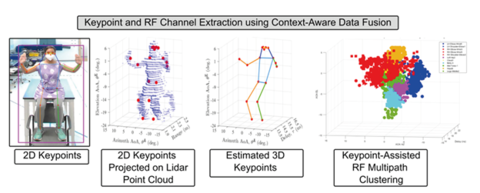Summary
An accurate characterization of how the wireless signal propagates through different environments and frequency bands, is key to developing radio frequency (RF) communications circuits. The lack of curated RF propagation measurement datasets and models has hindered the development of RF communication circuits and standards for decades.
This project will develop novel measurements and instruments for characterizing RF propagation and develop models and datasets for use in modeling and simulation of RF communications circuits.
Grand Challenge 4: Modeling and Simulating Semiconductor Materials, Designs, and Components
Description

Projection of the keypoints into the same domain of the multipaths. (a) Keypoints extracted from the camera images. (b) Extracted keypoints projected onto the Lidar depth maps. (c) Final keypoints projected into the azimuth, elevation, and delay domains.
The research community has long identified the need for propagation measurements to develop and evaluate communication circuits.
Since 2011, NIST has been to prototyping state-of-the-art channel sounders for measuring RF channel propagation. NIST current channel sounders include LIDAR and camera systems that are synchronized to the RF for additional context awareness and use AI/ML in post-processing and model development. These state-of-the-art sounders are extremely fast and capable of generating TB of data within few hours. However, processing the data for chip development and evaluation takes months and sometimes years.
This problem is not unique to the NIST instruments but is common to most channel sounders capable of generating large amounts of data. Overcoming this major hurdle, requires a new sounder design and implementation utilizing a combination of FPGAs and GPUs for the fast processing of the data as it is collected without sacrificing the measurement accuracy.
This project aims at significantly reducing the time it takes to develop insights or models from measurements and has the potential to be a game-changer for the RF circuit design lifecycle and the supporting tool development.
This project will also develop RF propagation measurement methods and the implementation of a proof-of-concept instrument that is capable of accurate characterization of the propagation environment in near real-time. In addition, this project will produce a library of propagation measurement datasets and models that would be used by the research community to spur innovation and expedite the development of communication technology standards.

